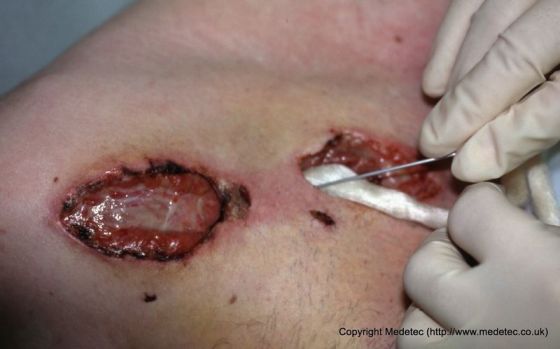Tunneling Wounds or Sinus Tracts
A tunneling wound or sinus tract is a narrow opening or passageway extending from a wound underneath the skin in any direction through soft tissue and results in dead space with potential for abscess formation. Also referred to as a tracking wound, these differ from undermining in that they extend in one direction, whereas undermining is destruction of the underlying tissue surrounding the wound margins.

Etiology
Perhaps the most common cause of wound tunneling is infection of the underlying tissues. While most often these infections are of cutaneous origin, it is also possible for the infection to stem from deeper structures, such as bone in cases of osteomyelitis. In addition, improper packing of the wound can cause wound tunneling, as too much packing can damage newly granulated tissue and not enough packing can lead to excess fluid in the cavity. Trauma or external pressures such as shearing can also cause suspected deep tissue injuries that can result in tunnel creation. Another potential cause of tunneling is the presence of foreign bodies in the wound, such as non-absorbable suture material or materials left over after incomplete cleansing of the wound.
Risk Factors
- Previous abscess formation
- Previous surgery at or around the site (as this increases the possibility of foreign bodies in the sinus)
- Recent trauma to the wound area (hematoma or ischemic changes)
Diagnostic Studies
- Sonography
- CT scan
- MRI
- Probing
Treatment of Tunneling Wounds or Sinus Tracts
Treatment of tunneling wounds is typically focused on treating the cause of the tunneling. The goal of treatment is to stimulate the growth of granulation tissue in the tract and to make sure that the wound edges do not close prematurely. The wound should be probed to assess the depth, direction and number of tracts, and the wound dimensions can then be drawn on the surface of the skin to help visualize the extent of the problem and track progress. When probing the wound, avoid cotton-tipped swabs and applicators as these can leave fibers in the wound. Soft polyethylene catheters or surgical stainless steel probes are frequently used for this task. In most cases, dressings that will adequately drain the cavity and promote granulation are sufficient, however in extreme cases it may be necessary to surgically lay open the wound to properly treat the wound. Opening up the wound in this way makes it easier to properly visualize, assess and clean the wound and helps prevent the wound edges from closing too early and forming another abscess. Negative pressure wound therapy may also be used to achieve these treatment goals.
References
Barnes L. Wound Tunneling. Ostomy Wound Management. http://www.o-wm.com/content/wound-tunneling. Published February 5, 2009. Accessed December 16, 2019.
Butcher M. Managing Wound Sinuses. Nurs Times. 2002;98(2)63.https://www.pilonidal.org/wp-content/uploads/2016/02/managing_wound_sinu.... Accessed December 16, 2019.
Cooper P. How to Probe a Wound During Assessment to Help Determine Treatment Options. Wounds UK. https://www.wounds-uk.com/download/resource/1051. Accessed December 16, 2019.







